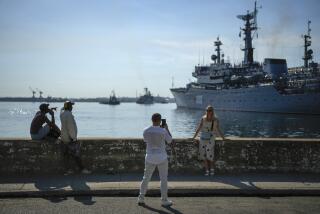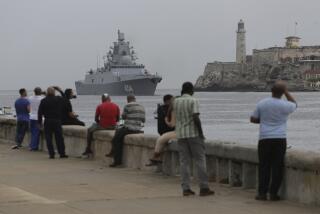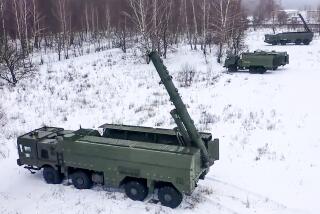Soviets Disclose They Had Warheads in Cuba : Seminar on ’62 Missile Crisis Reveals That U.S. Cities Were Targeted; Castro Plea for Attack Told
- Share via
MOSCOW — The world was even closer to the brink of nuclear war during the Cuban Missile Crisis of 1962 than has previously been thought, with warheads already on hand in Cuba for Soviet missiles targeted at Washington, New York and other major U.S. cities, according to fresh details of the crisis that emerged at an unprecedented meeting of the participants here Saturday.
One of the potentially most surprising disclosures emerged during a lunch break in the formal sessions. During lunch, one Soviet participant, a man described as having “definitive” knowledge of the subject, reportedly said that two days before the crisis peaked, Cuban leader Fidel Castro sent a desperate message to then-Soviet leader Nikita S. Khrushchev urging that the missiles be fired.
According to this account, that cable convinced Khrushchev that the confrontation had gone too far, and he decided to agree to U.S. demands that the missiles be withdrawn.
The existence of such a cabled plea from Castro could not be confirmed among available Soviet and Cuban sources attending the meeting here. But three conference delegates confirmed that they had heard the knowledgeable Soviet participant give the account during a session break, and they said that the report clearly took the American side by surprise.
Reporters were barred from all but the opening and closing sessions of the extraordinary, two-day seminar, which was organized jointly by the Soviets and officials of the Nuclear Crisis Project at Harvard University’s Center for Science and International Affairs.
While Washington had photographic proof that there were nuclear-capable Soviet missiles deployed in Cuba, the American side was never sure whether nuclear warheads to arm them were actually on the island, just 90 miles from the nearest landfall in the United States.
But Sergei Khrushchev, son of the late leader and one of the conference participants, told foreign journalists Saturday that the missiles could have been operational in less than a few hours, if his father had given the word.
Khrushchev, however, quoted Gen. Dmitri A. Volkogonov, head of the Moscow Military History Archive Institute, as telling conference participants “that even in the tensest moments, there was no command given to put the rockets in a state of military readiness, and the warheads were never put on the rockets.”
The younger Khrushchev, who was an engineer in the Soviet missile program at the time of the Cuban Missile Crisis, added that “even in the event of an American invasion or air strike, Soviet officers in Cuba had no orders to use the missiles.” The missiles were always under full Soviet control, he said, and Cuban officials said they were not even permitted onto the missile bases.
Asked about the reported cable from Castro urging his father to fire the weapons at the United States, Khrushchev commented, “I don’t know about this.”
1st Meeting of Participants
The Moscow seminar, held at an obscure guest house of a Soviet trade union organization, marked the first time that top American, Soviet and Cuban officials who were actually involved in the 1962 crisis have met to discuss it. Among some 50 participants were former Defense Secretary Robert S. McNamara and former Soviet Foreign Minister Andrei A. Gromyko.
Harvard’s Nuclear Crisis Project hopes eventually to publish at least an edited version of the meeting transcript, but in the meantime, most participants refused to provided details of their talks except anonymously.
Based on discussions with several of them, however, the picture that emerged from the conference is one of a vastly more complex confrontation than the version commonly known to Americans and one in which even the U.S. participants now say Washington played a much more equivocal role.
The best-known phase of the crisis began with the U.S. discovery in mid-October of 1962 that the Soviets were building nuclear-missile launching sites in Cuba. It became public Oct. 22, when then-President John F. Kennedy announced in a national television address that he had imposed a naval blockade on the island nation and pledged to do whatever was necessary to compel the withdrawal of the missiles.
Meanwhile, Kennedy warned, a Soviet missile launched from Cuba against any nation in the Western Hemisphere would be considered as an attack by Moscow on the United States and would trigger full nuclear retaliation.
No-Invasion Pledge
The public drama continued for six tense days until, on Oct. 28, Khrushchev agreed to remove the missiles in return for a pledge by Washington not to invade Cuba.
In fact, according to information emerging from the conference here, the Soviet decision to install the missiles in Cuba was made at least five months before the public crisis began and followed the development of a covert U.S. plan to try to overthrow the Castro regime.
Gen. Volkogonov reportedly told the conference Saturday that at the time, the Soviet Union had only “about 20” intercontinental ballistic missiles capable of reaching the United States from its own territory. That was a “shockingly low number,” according to one surprised American official, and only a fraction of the total estimated at the time by the CIA.
It meant that the 42 intermediate-range Soviet missiles either installed or in transit to Cuba by October would have represented more than two-thirds of Moscow’s ability to deliver a nuclear strike on American territory. The warheads had arrived on the island by September, 1962, the Soviets were quoted as saying.
The Soviets also said that because they had so few missiles at the time, it was their nuclear policy to target “U.S. population centers and leadership cadres” rather than military installations or troop staging areas, according to one participant. The Cuban missiles were targeted at Washington, New York and other major cities within their range, he added.
In another surprise, the Cuban delegates to the conference disclosed that Havana had urged the Kremlin three times to make a public announcement of its intention to install nuclear missiles in Cuba, according to one participant.
Kennedy, in his public announcement, stressed that the weapons had been moved secretly onto the island, and former Kennedy Administration officials have said since that Washington would have been hard-pressed to win world support for blocking deployment of the missiles if it had been undertaken openly.
Delegates here confirmed that during the formal sessions, Cuban and Soviet officials alike underscored their conviction that by October, 1962, a U.S. invasion of Cuba was imminent. Cuban delegates reportedly said that they expected 400,000 Cuban soldiers and civilians to die in such an attack.
American officials continue to insist that the United States had no such intention, although McNamara conceded Saturday that he had told the seminar, “I could understand why the Cuban and Soviet leaders at that time believed the U.S. was intending to invade Cuba.”
Participants quoted Alexander I. Alekseyev, who was ambassador to Cuba at the time, as saying that Castro, who had previously been calm throughout the crisis, became particularly agitated by Oct. 26. Fearing a U.S. air strike, he reportedly spent that night in a bomb shelter, where he and the Soviet envoy drafted a cable to Khrushchev warning of intelligence information that a U.S. attack would come within days or possibly hours.
Urged Firing of Missiles
The reported account during lunch by the knowledgeable Soviet delegate picks up at that point. The account affirms that Castro urged Khrushchev to fire at least some of the missiles targeted on the United States. Luncheon witnesses said it was unclear from the Soviet delegate’s account whether Castro asked that the missiles be launched preemptively or at the moment of a U.S. invasion.
Before the Moscow meeting, the Cubans were generally considered by U.S. participants in the 1962 crisis to have been almost extraneous to its development. They tended to see the crisis as strictly a Soviet-American showdown over an issue of strategic advantage.
The Moscow conference appears to have significantly altered that perception. As Scott Armstrong, executive director of the National Security Archive, put it during the public, closing session of the conference: “Cuba has been put back into the Cuban Missile Crisis in a very definite way here.”
Jorge Risket Valdes, a member of the Politburo of Cuba’s ruling Communist Party and a leader of the Havana delegation here, proposed that a sequel to this conference be held in Havana.
“We feel this would be just and make a further contribution to our understanding,” he said.
The participants have scheduled a final news conference for today.
More to Read
Sign up for Essential California
The most important California stories and recommendations in your inbox every morning.
You may occasionally receive promotional content from the Los Angeles Times.












